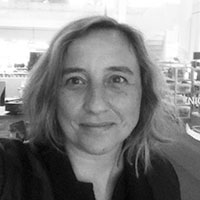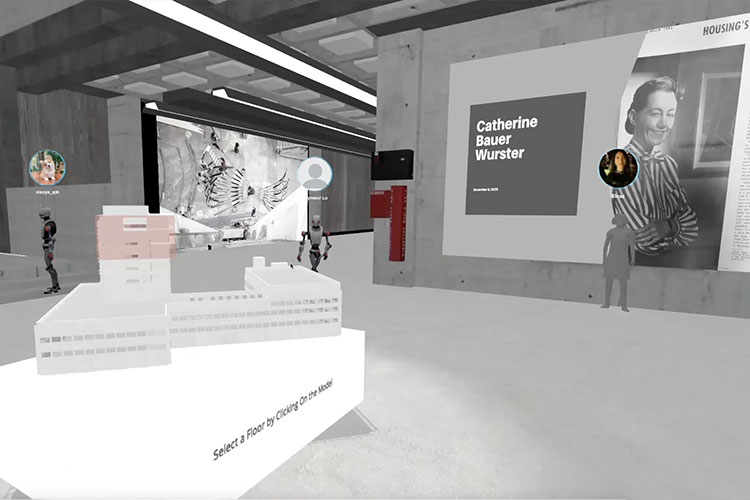Missing in-person interaction, Berkeley’s design school launches virtual reality building
College of Environmental Design creates online program that has potential to change remote learning
March 25, 2021

Virtual Bauer Wurster’s digital studio desk space will allow students and instructors in the College of Environmental Design to connect and collaborate on projects. (Photo courtesy of Luisa Caldas)
A team of UC Berkeley students and virtual reality specialists in the College of Environmental Design (CED) have found a way to visit Bauer Wurster Hall, the college’s iconic hulking concrete home building, without stepping foot on campus.
The team, led by Berkeley architecture professor and XR Lab director Luisa Caldas, recently launched “Virtual Bauer Wurster,” a fully immersive virtual reality program that allows CED students and faculty to wander exhibit spaces, review models and engage almost like they used to from the comfort and safety of their own homes, using just a computer.
Virtual Bauer Wurster Exhibition
Join Berkeley’s College of Environmental Design March 29 for a public discussion and exhibition with Deanna Van Buren on Building for a Decarceration Nation.
The project was initially created as a tool to replace the spark of in-person interactions lost when Berkeley moved to remote learning a year ago. But the platform will stick around long after the campus reopens, said Vishaan Chakrabarti, dean of the school.
“Students and faculty can create their own experiences and communicate in dozens of ways while participating in collaborative projects and experiencing each other’s work as they would in-person,” Chakrabarti said. “We hope this new virtual space can provide a stopgap for our current circumstances and new possibilities for the future of online learning.”
The virtual space is the first of its kind at Berkeley, and can be accessed by CED students and faculty through a custom application and/or a web-based platform created by Caldas and her team of architecture and computer science students. Users create an avatar that represents them and can simulate walking through Bauer Wurster Hall, passing through familiar stairwells, courtyards and other areas of the 10-floor building.

Luisa Caldas is an architecture professor and director of the XR Lab. (UC Berkeley photo)
Participants can browse graduate thesis model displays or student and faculty reviews pinned to digital whiteboards in the lobby. There is also potential to connect with other students and faculty in the building through Slack messaging or Zoom video.
“How do you communicate inside a virtual environment so that it isn’t an isolated experience, but a collective one? That’s ultimately what we wanted to achieve,” said Caldas, who is an expert in immersive environments and augmented reality. “We want students to be able to create synchronous interactions in the space and have tools that fit their style of communication.”
CED Ph.D. student Elnaz Bailey was one of 10 students who helped Caldas design the platform and said the most unique aspect of the program is the studio space that provides a desk for each student. Users have the ability to leave their classmates a digital sticky note or message.
Bailey said students can also upload their 2D drawings and 3D models to their desks. Their colleagues can then choose to click into those designs for a closer look.
“They can actually go into your project, so it’s like you’re hosting an open house for your work,” said Bailey, who helped design exhibitions and interaction functions on the platform. “I think that’s the most powerful part of this project. They can walk into your space and give you feedback or learn from what you did to apply to their work.”
CED alumnus and entrepreneur Shawn Tsao helped fund the project when the pandemic began. He felt students didn’t have a way to collaborate in a studio environment. Tsao was also intrigued with the potential capabilities that a virtual space could have on the future of architecture as an industry.
“I do see in the future that people will be working in augmented reality, and in virtual worlds, in virtual everything,” he said. “And for Berkeley students to be able to learn about that now, I think will be key in driving the future of architecture. … I’m just happy to be part of that journey.”
Architecture department chair Renee Chow said the project will not only benefit current students and faculty. It will also improve the college’s ability to reach out to prospective students during the pandemic.
The architecture department hosted a recruitment event earlier this month featuring the project that Chow said went “fabulously.”
“They couldn’t physically visit campus, but through the virtual space they were able to get a sense of the building and the different exhibitions and work we featured,” said Chow. “They could also meet and talk to each other and go up into the studios to see what kind of work our graduate students are up to. That was something other universities can’t offer right now.”

The Virtual Bauer Wurster re-created many spaces, including the building’s lobby. (Photo courtesy of Luisa Caldas)
Caldas said the virtual space has gone through several iterations since the project began last June. The most recent version was released last week and allows for all uploaded work to be archived in a database. Future additions to the platform include incorporating a moving sun to allow students to understand how daylight can be used as an energy source in their designs.
Architecture graduate student Kris Swick worked with Caldas on designing the platform, giving input on user interface functions. Swick, whose graduate thesis focuses on “do it yourself” architecture, said Virtual Bauer Wurster gives students the ability to collaborate and identify issues with their designs that they otherwise wouldn’t have seen.
“Drawings and physical models don’t allow you to see the structural issues you can find in a virtual 3D space,” said Swick. “In these types of applications, there’s nothing hiding the reality of the building from its user. It allows you to focus on the functionality of the building.”
On March 29, Virtual Bauer Wurster will hold its first public event, the Deanna Van Buren’s prestigious Rupp Prize exhibition Building for a Decarceration Nation. It will include a gallery talk and Q&A session. The exhibition will remain open through May 15.
Caldas said she hopes the event gives the public and campus community some insight on how the virtual space can be applied to other colleges and departments on campus. Most of all, she looks forward to the community the platform will help to create.
“This is really about keeping community together,” said Caldas. “And we’ve created a way for that community to continue to grow and engage despite being physically away from each other.”